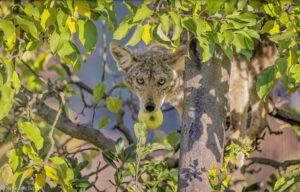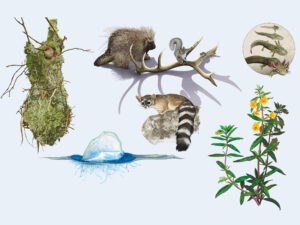BN: When did you come to the Bay Area and what first brought you here?
CT: I came to the Bay Area in 1988 after graduating from college. I wanted to live in an area with a rich diversity of habitats, geology, history and culture. I think I found it! My younger years were fairly nomadic, moving every couple of years on average, so it’s great that now I finally have some roots!
BN: Tell us about your early experiences working in a park.
CT: My first job with a parks system came during a summer in college working with the resource management program at Shenandoah National Park in Virginia. That was exciting! I got to radio track black bears, electroshock streams during trout surveys, participate in flying squirrel census studies and acid rain plant biodiversity studies, and I got my first taste of tracking and scatology, which have become my passions!
BN: How did you originally become involved with the East Bay Regional Parks?
CT: I wandered into a visitor center one day in 1988 and asked how one went about getting a job as a naturalist. I was new to the area and didn’t know much about local flora, fauna and culture, so the naturalist told me about the volunteer docent training program at Sunol Wilderness. At the same time, I was working as a ranger/naturalist for the Livermore Area Recreation and Park District, which gave me lots of diverse and wonderful experiences from running a nature camp, to coordinating special events, to leading hikes. The East Bay Regional Park District hired me as a naturalist in 1991 and I’ve been here ever since.
BN: Tell us a bit about your passion for … scat.
CT: I’m always checking out scat on the trails to see who has been around and who has been eating what. I’m even thinking of changing my name to “Scat” Taylor! I love to point it out on my hikes and incorporate scatology into many of my programs. I even have my own collection at home.
BN: How did this scat “obsession” begin?
CT: One of my primary assignments at Shenandoah (National Park) was a bobcat scatology project. The goal of the study was to see if bobcats preyed upon deer. I spent a good deal of time hiking around finding scat, baking it to get rid of harmful and nasty organisms and then sitting in a lab and dissecting the scat hair by hair and keying the hairs out. Hairs that could not be identified by key were identified by comparing them with fur from various frozen mammals. So if a hair stumped me, I’d go into the freezer and start plucking out likely suspects – deer armpit, skunk belly, elbow hair of coyote. I felt like such a detective! So of course I was hooked for life. There is so much information out there – what animal passed by here, how long ago, what did it eat, what changes occur through the seasons.
BN: What did you find out in your bobcat study?
CT: I found things like skunk, baby fox, and rabbit, but I didn’t find any deer hair, so I went around for 20 years stating with conviction that bobcats did not prey on deer. Then a large bobcat at Sunol proved me totally wrong! It took down a yearling deer and then guarded its kill.
BN: What’s one of the most interesting programs you’re working on these days?
CT: The answer to this varies from week to week since we do so many different programs throughout the year. Currently I’m doing a lot of astronomy programs: Taking families out at night and exposing them to the wonders of the night sky, especially during the Perseid Meteor shower, is always a highlight of my year. And I just finished doing a “Batty Overnight “campout with pre-schoolers. We sat by the lake after sunset in a bat “commuter zone” with bats flying from their roosts to feed over the lake.
BN: How can you tell you’re having an impact on people?
CT: There is no cut-and-dry way to evaluate the impact you have on people during the short time that you have with them. But over the years, I do know that I have had an impact. A college student who participated in one of my pre-school programs as a young child wrote about an experience she had in that program for her college magazine. Her mother sent me a copy of the article. I actually recalled the very moment that she was writing about and couldn’t believe that she had cherished this memory all of her life!
BN: What do you like most about the work you are doing?
CT: I have always played in wild places, and to be able to earn a living playing in the outdoors is a phenomenal thing. To be standing with a group on a hillside full of wildflowers and realizing once again that this is your JOB fills you with wonder. When I look back over the years, I think how fortunate I have been. I’ve worked with amazing people, dedicated volunteers and very enthusiastic program participants.
It’s great to get to know an area so intimately – knowing what flower is blooming on what rock outcrop during a particular month, or where the different bats are found, what a coyote scat will look like during different months of the year, where you will most likely find mountain lion tracks, where the best stargazing areas are. That sort of knowledge just can’t be found in any book.
And then when someone tells you after a program that they will never look at the night sky the same way again, you know that you have touched them. It makes all the effort worth it when you hear things like this, knowing that you can have a lasting impact on people – long after your hike or program is over.
BN: Who or what in the Bay Area inspires you these days?
CT: Currently, I draw most of my inspiration from the public – I see the world anew through the eyes of someone who hasn’t hiked in that park before, or has never looked at the sky and been able to recognize a constellation, or has never let a tarantula walk over their hand. My other inspiration comes from farmers, farmer’s markets and community gardens. I try to grow most of my own food and turn almost everything useable into compost with my worms.
BN: What’s your favorite park, hike, or place to go in nature in the Bay Area?
CT: Of course Sunol is my “home” and would have to be the top of the list. Leading trips to Vasco Caves always fills me with awe. There is something very spiritual about that area. But when I need to get away from work and take a quick trip somewhere, I head to Uvas Canyon and hang out by the waterfalls or watch the fog roll into San Francisco from Hawk Hill in Marin or take my kayak up to Tomales Bay. There is so much left for me to explore here in the Bay Area that I know I could have a new favorite place every week!
Interested in learning more about scat or other scintillating natural phenomena? Check out Cat Taylor’s naturalist programs in the Sunol-Ohlone Regional Wilderness this fall, including an October 29th class on scatology! (download the pdf file of course listings here.)

.jpg)



